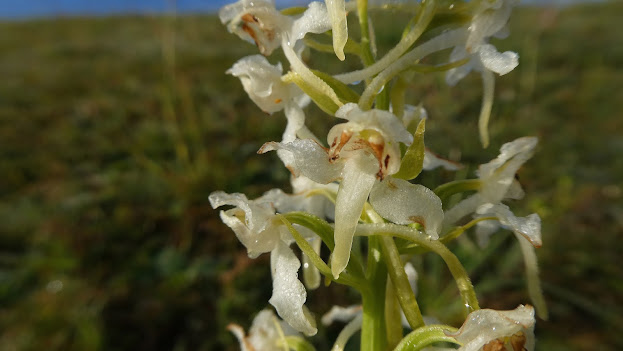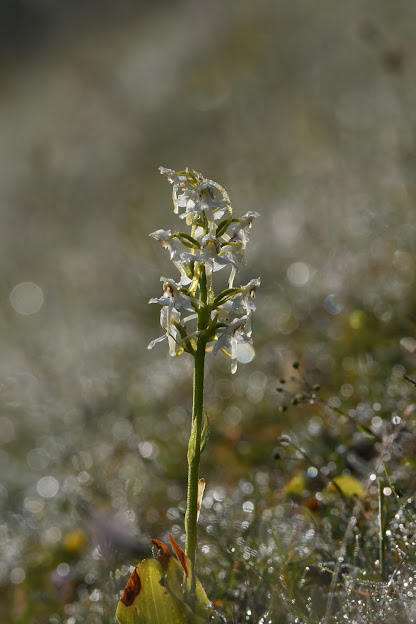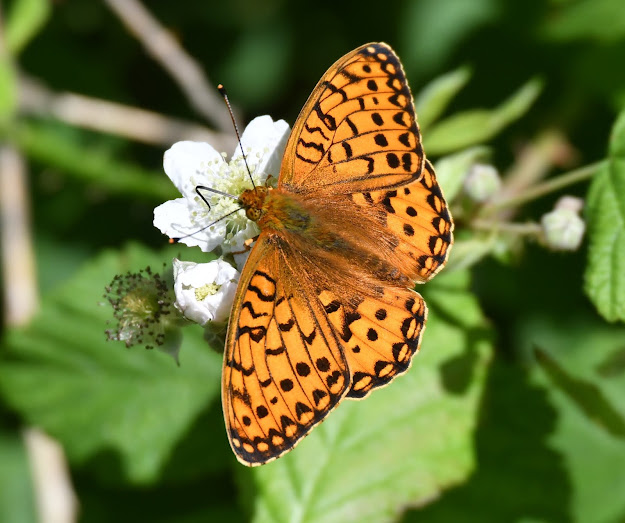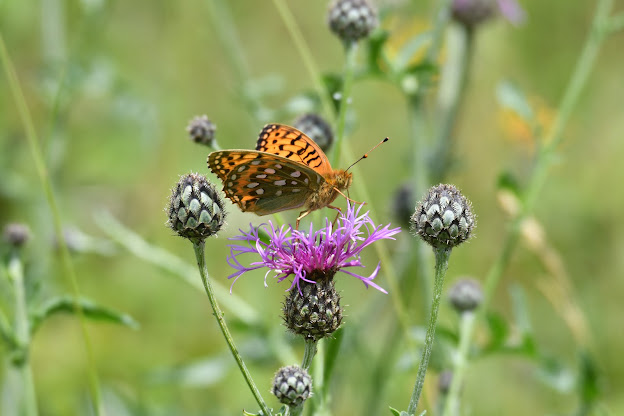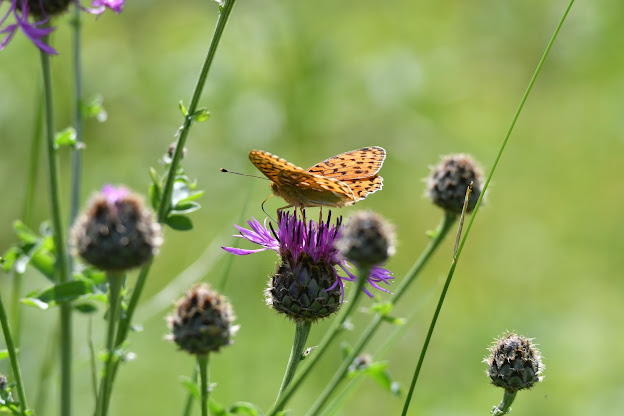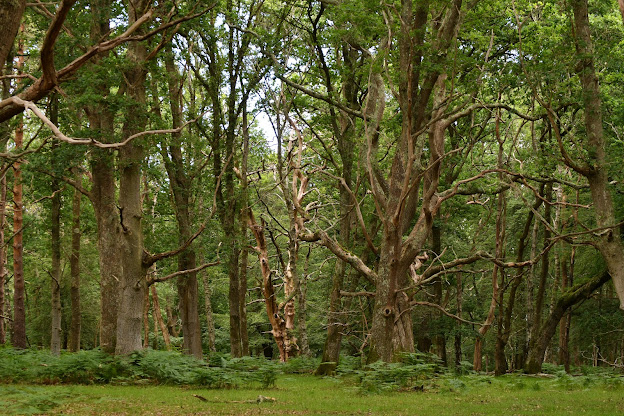There are some anomalies however, little blips in the modern fabric and one such place draws us back time and time again. A beautiful epicentre of biodiversity set in the chalk downlands of North Hampshire with a real sense of place.
As we brushed past the grasses our trousers and boots were immediately sodden as we absorbed the diamond droplets.
Further on, there were more diamonds in the grass and ones we had hoped to see.

It's basal leaves clearly nipped by frost early on in it's growth.
As we followed the ditch northwards we stopped to record as much as we saw.
I've seen a few Brown Hare here before but usually their bounding bottoms and long ears as they disappear into the distance having been disturbed. The long grasses always provide good camouflage, so the first sign of them is their rear end at speed in the opposite direction. No change here today.
The northern part of the reserve takes in the old firing ranges. Large triangular banks that provide shelter for wildflowers and in turn many invertebrates.
Dark Green Fritillaries such as this were in their prime of emergence. These stunning orange insects are strong flyers. They need to be as they often habit open downland which is quite windy at the best of times.
As we concentrated on the Dark Green, yet more appeared to feed on the bramble flowers. It took us a few seconds to realise a Silver Washed Fritillary had joined the nectar party. Not one but two..
Dark Green again, noticeable by the white dots on the underwing as apposed to the stripes of the Silver Washed.
Silver Washed..
The name Dark Green being obvious by the colour of the underwing
A passing Red Admiral dropped in briefly also, albeit a little distant amongst the nettles.
Being the middle of June, Meadow Browns were the most common species around.
The Dark Green was proving to be a constant companion. I hadn't seen one for some three years or so before this year for one reason or another. Now it was making up for lost time. We always joke when we've seen so much of one species that we're bored with it now. The truth is with this one, it's always a pleasure to see. That little iridescent shimmer of green can be seen from above here.
You'll remember what I was saying previously about the Marbled White. Well here it was again, dancing around in front of us tantalisingly before settling on the valerian. Ages since we saw the last one !
Last up before we crossed the road again and returned to Martin Down was a sorry sight of a male Common Blue coming to the end of it's days. This first brood will have dutifully performed it's reason for being an adult - to breed and carry on the line.
This is a common territory for them on their return from Africa to breed. We've seen them on this patch before.
Corn Buntings still sang from the low hawthorn bushes to distract us from the fritillary onslaught !
Some even fought for the best nectar source.
In the end they realised there was room enough for two !
It diligently worked over the knapweed.
From our constant walks through the seasons we get a general idea of what has had a good year or the opposite. In recent times, Small Tortoiseshell like the Small Copper have fared poorly, which has to be said has happened to a large proportion of British butterfly species.


As we had to pass through the main bulk of the New Forest to get home, it was perfectly set to drop into Shatterford Common and Denny Wood near Beaulieu Road railway station.
There were Redstarts however. An adult and at least a couple of juveniles, freshly fledged from the nest.
They always play hard to get though, so this was our best shots despite our patience.
Natural and untainted, managed in harmony with nature, Martin Down captures the imagination of how old England looked like before we put ourselves above all else, above all living things.
Every time I step from the car there is a sharp intake of breath, like being transported into an ancient spiritual world full of wildlife. This is intensive nature at it's very best.
I had arranged to meet my friend Chris for our second walk here in as many months. It would be interesting to see what had changed in four weeks and what different species we would encounter from before.
There had been light overnight rain which enhanced the smells all around and the wind was still. The droplets left were set like jewels on the flora in the early morning sun.
Further on, there were more diamonds in the grass and ones we had hoped to see.
Orchids thrive on the chalk. In May, the Common Spotted Orchids were in the ascendancy along with early showing from the Pyramidal too.
Much less common are the Greater Butterfly Orchids. They had been reported back in May when we were last here but the analogy of a needle in a haystack was no more appropriate than then.
On our approach to Bokerley Ditch that runs the length of the reserve, the aforementioned orchid stood out like a ghostly white thumb at dawn.
Lying on a steep bank, drenched in dew, we set about trying to capture it's beauty in the early morning light, whilst struggling for a foothold and trying not to squash anything else beneath our feet.

It's basal leaves clearly nipped by frost early on in it's growth.
Fragrant Orchids, another delicate species taking over where others had been profuse a month before.
The hollow of the ditch provides a perfect microclimate and protection from the wind.
And just like buses, when you finally see the orchid you are after, more appear !
The hollow of the ditch provides a perfect microclimate and protection from the wind.
And just like buses, when you finally see the orchid you are after, more appear !
Last time in May we took for granted we would see our yearly Turtle Dove. We drew a blank then, so we were more hopeful now.
Their scientific name is Streptopelia Turtur. Turtur coming from the call it emits and subsequently giving it it's common name. It's more of a purring sound in reality but very soothing.
It's very beautiful too, but in steep decline. Martin is a haven for them but they barely number into in double figures even in this outstanding reserve.
We were lucky to hear and photograph this individual on this occasion. They are notoriously nervous unlike the Collared Dove for instance. Persecution across the continent has a role to play in this no doubt. They are routinely shot in places such as Cyprus and Malta on migration. Tradition as usual playing it's role in this senseless murder. Hopefully one day it will end before they are extinct in the UK.
As we reached the lowest point of the ditch before it rises gradually again in it's constant path North, it's always a point of place to stop and take in it's sights. There's always something special to see at this juncture.
Common Valerian, the wild cousin of the domesticated and ubiquitous Red Valerian that appear everywhere in Spring were in full bloom.
Earlier views from the top of the down took in swathes of red across the cultivated fields.
These turned out to be washes of poppies.
We found a few more in the spent rapeseed fields on the opposite bank to Bokerley Ditch.
The northern part of the reserve takes in the old firing ranges. Large triangular banks that provide shelter for wildflowers and in turn many invertebrates.
Lots of Chalk Fragrant Orchid grew, so much so, you had to be careful not to tread on any. What was once a military area has now turned into an orchid minefield.
Pale Common Spotted too.
Having left the firing range, we carried on Northwards. Many butterflies still around us including Large Skippers.
That quintessential trilling sound of Skylarks accompanied us all the way, or so it seemed.
While the occasional 'Little bit of bread and no cheese' song of the male Yellowhammer rang out.
The Corn Bunting is a member of the same family as the Yellowhammer with similar serrated looking bills, perfect for opening seeds. Their call is like the jangling of keys.
Pale Common Spotted too.
Having left the firing range, we carried on Northwards. Many butterflies still around us including Large Skippers.
While the occasional 'Little bit of bread and no cheese' song of the male Yellowhammer rang out.
The Corn Bunting is a member of the same family as the Yellowhammer with similar serrated looking bills, perfect for opening seeds. Their call is like the jangling of keys.
Once common before the change in farming practices, they are now quite rare, unless you visit places like this or farms that work in harmony with nature locally.
This one was a bit put out at being disturbed by a Whitethroat. These feisty little warblers proving it's not the size of the bird in the fight but the size of the fight in the bird.
No common name for this beautiful beetle, only the scientific tongue twister, Cryptocephalis hypochaeridis which is common on chalk downland and usually on yellow flowers.
Now at the northern car park at the edge of the Down there's still plenty more to see if you walk across the road into the fields opposite.
This one was a bit put out at being disturbed by a Whitethroat. These feisty little warblers proving it's not the size of the bird in the fight but the size of the fight in the bird.
No common name for this beautiful beetle, only the scientific tongue twister, Cryptocephalis hypochaeridis which is common on chalk downland and usually on yellow flowers.
Chimney Sweepers are day flying moths that are quite common here.
Now at the northern car park at the edge of the Down there's still plenty more to see if you walk across the road into the fields opposite.
Our first Marbled White of the year proved elusive at first but we worry unnecessarily. We'll see these lovely monochrome butterflies time and time again in the coming days if not later in the walk.
and Large Skipper again
Then it was Fritillary time. These can confuse but with a little time and study it's quite easy to tell them apart.
If Martin Down itself didn't have enough butterflies, these fields were exploding with them the further we walked.
Small Skipper...
Essex Skipperand Large Skipper again
Then it was Fritillary time. These can confuse but with a little time and study it's quite easy to tell them apart.
Dark Green Fritillaries such as this were in their prime of emergence. These stunning orange insects are strong flyers. They need to be as they often habit open downland which is quite windy at the best of times.
Silver Washed..
Dark Green...
The name Dark Green being obvious by the colour of the underwing
A passing Red Admiral dropped in briefly also, albeit a little distant amongst the nettles.
Being the middle of June, Meadow Browns were the most common species around.
The Dark Green was proving to be a constant companion. I hadn't seen one for some three years or so before this year for one reason or another. Now it was making up for lost time. We always joke when we've seen so much of one species that we're bored with it now. The truth is with this one, it's always a pleasure to see. That little iridescent shimmer of green can be seen from above here.
You'll remember what I was saying previously about the Marbled White. Well here it was again, dancing around in front of us tantalisingly before settling on the valerian. Ages since we saw the last one !
Small Copper's are having a good year it seems. I've stumbled across them constantly throughout the season.
Yellow Shell moths are day flying. Another moth species debunking the myth that moths are dull and boring insects and only come out at night.
Last up before we crossed the road again and returned to Martin Down was a sorry sight of a male Common Blue coming to the end of it's days. This first brood will have dutifully performed it's reason for being an adult - to breed and carry on the line.
No sooner as we had crossed the road than a Lesser Whitethroat piped up in the bushes.
The rarer cousin of the Common Whitethroat and much more reticent. Although it did show well for a few seconds, bucking it's normal trend of hiding deep in the foliage and calling at us frustratingly without a sighting.
Our friend Kes did too albeit fleetingly and in the sun making it harder to capture.
Another day flying moth, the Five Spot Burnet
Back on the path that hugs the edge of Bokerley Ditch we retraced our steps.
Our friend Kes did too albeit fleetingly and in the sun making it harder to capture.
As we followed the path around towards the old firing ranges again, I stopped to capture the sound of the Skylark serenading us from the heavens. There was a perfect gap in the clouds, a lovely calm moment on a glorious late Spring afternoon in the English countryside.
While constantly all around the butterflies continued to pass us or stop on the myriad of nectar sources.
It's an endless sensory extravaganza, being alert is the key at all times. Blink and you can literally miss something although you need an eye in the sky and one on the ground. Even one in the back of your head would help too !
With so many orchids it's a challenge to find one in perfect bloom. This common spotted was close to perfection
Still more Dark Greens' flitted around us and stopped often on the Knapweed. Forgive my indulgence but it's difficult to ignore these wafer winged stunners.
Corn Buntings still sang from the low hawthorn bushes to distract us from the fritillary onslaught !
Some even fought for the best nectar source.
In the end they realised there was room enough for two !
It diligently worked over the knapweed.
From our constant walks through the seasons we get a general idea of what has had a good year or the opposite. In recent times, Small Tortoiseshell like the Small Copper have fared poorly, which has to be said has happened to a large proportion of British butterfly species.
This year we've seen quite a few of them. Nothing like the numbers I remember a few years ago, or even as a child but a marked improvement. The general trend is downwards however so we need to do our best to help mitigate it's and many others decline.
Another DGF, oh go on then ?!
A Small Skipper tries to avert our gaze...
Nope, it's just too tempting !
Still the Skipper tries..
We were now back at the crossroads. The sun had retreated behind the clouds, pushing the pause button on the butterfly action.
Another DGF, oh go on then ?!
Nope, it's just too tempting !
We were now back at the crossroads. The sun had retreated behind the clouds, pushing the pause button on the butterfly action.

I remember some two hours ago when we were chasing our first Marbled White around like it was the last we would ever see.
We stumbled across two mating in the shade. Their torpor while the sun was hiding allowed us to get in close.
I pulled out my compact camera for some macro shots but as I did so I felt a little strange embarrassment at intruding on their copulation.
Didn't stop me enough though...

As we pulled our tired limbs towards the car park we contemplated our next destination as we had time on our hands thanks to putting in our graveyard shift. Gluttons for punishment but ever hopeful of a pot of gold a the end of the rainbow.
This is almost a bi-yearly treat depending on our timing and our wont. In winter we look for Great Grey Shrikes that hunt anything from Beetles to Meadow Pipits and Spring for Silver Studded Blue butterflies and Redstarts.
Post lockdown the forest was busy and some car parks were closed so it took a little longer to find a space.
We found out later that the car park at Shatterford was closed not due to the pandemic, but because there were rare nesting birds near to the car park and as it's a popular area, they were protecting the chicks.
Silver Studded Blues are one of those rare butterflies that can congregate in serious numbers and I'm talking hundreds if not thousands.. Shatterford in the past has been one of those places.
Although I had seen just a handful on my local patch, it's always a pleasure to catch them while they are still on the wing in the short couple of months that the adults are around, so we were hopeful of witnessing a real bounty.
No sooner as we had left our vehicles we had one dancing around our feet. We rubbed our hands in anticipation, fill yer boots time ! This proved to be a false dawn unfortunately. Just a rogue individual it seemed.
We arrived at the usual spot where they breed on the heather, they didn't even get into double figures.
We pondered on this. The heather clad heathland they call home was devoid of flowers. Perhaps this had a hand as there was little nectar source?
Or maybe they move on to fresher pastures where the breeding habitat is better?
They have a close relationship with black ants that help raise the pupae, so maybe there's a case to be had there also. Either way there is a complex thing going on. There's no single explanation, only study of the species can uncover the reason.
We carried on our walk into Denny Wood albeit a little crestfallen at our lack of SSB action.
There were a couple at the forest entrance but little else.
There were Redstarts however. An adult and at least a couple of juveniles, freshly fledged from the nest.
They always play hard to get though, so this was our best shots despite our patience.
The adults are so stunning. The black face with a slate grey cap set against that russet breast.
The beeches and the oaks of Denny Wood looked so stunning with the flush of spring green.
We took on a circular route that encompasses a place called Pig Bush. Always love that name..
The beeches and the oaks of Denny Wood looked so stunning with the flush of spring green.
We took on a circular route that encompasses a place called Pig Bush. Always love that name..
I picked out a Treecreeper doing exactly as it says on the bird. It crept it's way up the trunk of an oak, occasionally stopping to dig under the bark for some tasty morsels.
The forest is full of deer. So much so it's literally killing the forest. They are eating the new growth out of existence. The lack of apex predators being the main issue. Plus many of the deer are not endemic to the country. Only Scottish Red and Roe deer are in the UK. The rest were introduced by the Romans or Normans or have accidentally escaped.
These are Fallow Deer that we disturbed here. Bolting off for a bit of peace and quiet.
Pig Bush has a small stream flowing through it. This lowland part of the heath can get very moist naturally, even in the drier months. The sphagnum moss and peaty soil acts like a sponge to keep the ground moist unless there is a serious heatwave in Summer.
Pig Bush has a small stream flowing through it. This lowland part of the heath can get very moist naturally, even in the drier months. The sphagnum moss and peaty soil acts like a sponge to keep the ground moist unless there is a serious heatwave in Summer.
At the bridge that spans the brook there's always a chance of dragonflies. We had a very brief but positive ID of a male Broad Bodied Chaser before it left to hunt elsewhere.
The New Forest ponies are a big draw for the tourists. It was foal time too so how could I resist?
Patches of bell heather had some of the flowers still in bloom. And as if by magic the Silver Studdeds' put in an appearance. Still not in the numbers we had envisaged but you take what is put before you and say thanks.
Our final few metres around the circuit revealed the reason why the main car park was shut. An adult Curlew circled. Clearly a nest and young nearby, we kept to the paths so not to disturb them. They are red listed as a breeding species in this country. A once common sight with the eerie call of shore and moor, they are in danger of disappearing altogether. What a travesty that would be?
We stopped by the pools to admire the forest of Cotton Grass flourishing across the boggy plain.
The New Forest ponies are a big draw for the tourists. It was foal time too so how could I resist?
Patches of bell heather had some of the flowers still in bloom. And as if by magic the Silver Studdeds' put in an appearance. Still not in the numbers we had envisaged but you take what is put before you and say thanks.
Our final few metres around the circuit revealed the reason why the main car park was shut. An adult Curlew circled. Clearly a nest and young nearby, we kept to the paths so not to disturb them. They are red listed as a breeding species in this country. A once common sight with the eerie call of shore and moor, they are in danger of disappearing altogether. What a travesty that would be?
We stopped by the pools to admire the forest of Cotton Grass flourishing across the boggy plain.
Well that was a heck of a long day but full of the sights of what can be seen in the natural world just on our doorstep. A Little bit of what Britain used to be like.
The title of this post is a line taken from the track : Little Britain by Dreadzone from their seminal album Second Light from 1994





